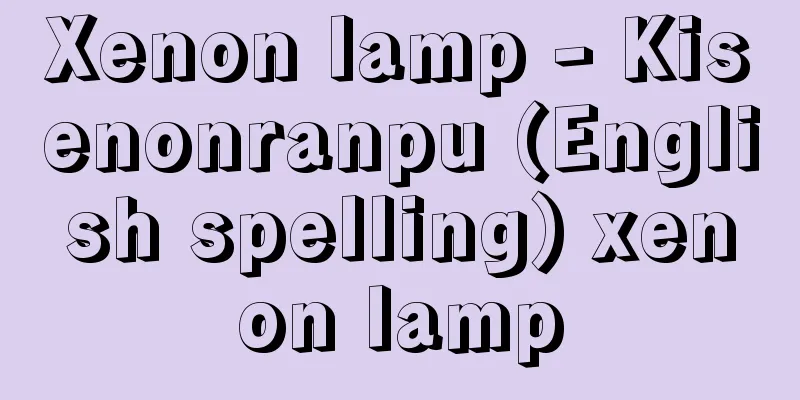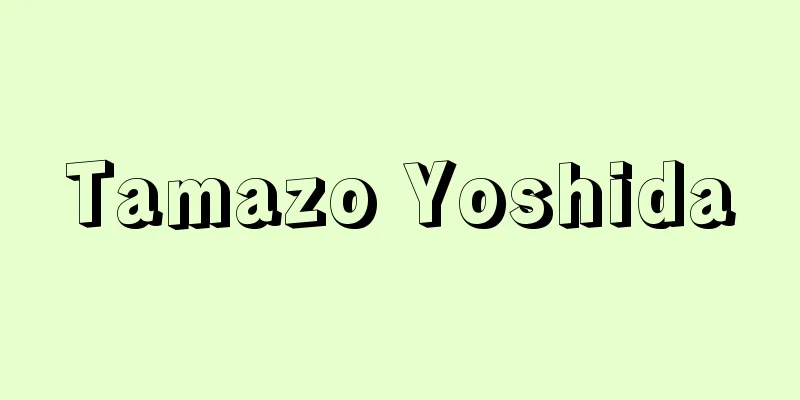Xenon lamp - Kisenonranpu (English spelling) xenon lamp

|
A lamp that uses discharge in xenon gas. It produces a stable light output as soon as it is turned on, and emits a continuous spectrum that ranges from the ultraviolet through the visible and infrared regions. The light from the ultraviolet to the visible region in particular is very similar to natural daylight. Xenon lamps were researched in Germany from around 1933, and put to practical use in 1944 by Paul Schulz. In Japan, they began to be produced around 1952 (Showa 27), and were mainly used as flash lamps. A short arc lamp filled with high-pressure xenon gas was announced in 1957. A short arc xenon lamp is a quartz tube with a gap of a few millimeters between the anode and cathode, sealed inside the tube, and lit with direct current. The enclosed xenon gas reaches a pressure of 20 to 40 atmospheres when lit. It is a point light source with high brightness and good color rendering close to natural daylight, so it is used as a standard white light source, for film projection, printing plate making, fading tests, solar simulators, etc. Long-arc xenon lamps are made of a long quartz tube with electrodes sealed at both ends, and the xenon gas pressure is about 1 atmosphere. They are generally powered by alternating current. They have high brightness and are used for fading tests, photoengraving, floodlighting, etc. Xenon flash lamps are made of straight, spiral, U-shaped, or ring-shaped quartz or glass tubes with electrodes sealed at both ends, and contain xenon gas at tens to hundreds of torr (1 torr is a pressure of 133 pascals). Energy stored in a capacitor is applied in pulses to cause an instantaneous discharge. They are used for photography, aircraft guide lights, laser excitation, etc. [Akio Obara and Makoto Bessho] [Reference] |©Shogakukan "> Xenon lamp structure Source: Shogakukan Encyclopedia Nipponica About Encyclopedia Nipponica Information | Legend |
|
キセノンガス中の放電を利用するランプ。点灯と同時に安定な光出力が得られ、その発光は紫外域から可視域を経て赤外域にわたる連続スペクトルからなっている。とくに紫外域から可視域にかけての光はきわめて自然昼光に近似している。キセノンランプは1933年ころからドイツで研究され、1944年にシュルツPaul Schulzによって実用化された。日本では1952年(昭和27)ころから製作され、主としてフラッシュランプとして用いられた。また、1957年には高圧キセノンガスを封入したショートアークランプが発表された。 ショートアークキセノンランプは、石英管内に陽極と陰極間を数ミリメートルの間隙(かんげき)に封止し、直流で点灯する。封入キセノンガスは点灯中20~40気圧にもなる。点光源で輝度が高く、自然昼光に近く演色性がよいので、標準白色光源、映写、印刷製版、退色試験、ソーラーシミュレーターなどに用いられる。 ロングアークキセノンランプは、長形の石英管の両端に電極を封止したもので、キセノンガス圧は、1気圧程度である。一般に交流で点灯する。輝度が高く、退色試験、写真製版、投光照明などに用いられる。 キセノンフラッシュランプは直管形、螺旋(らせん)形、U形、環形などの石英管、またはガラス管の両端に電極を封止し、数十~数百トル(1トルは133パスカルの圧力)のキセノンガスが封入されている。コンデンサーに蓄積されたエネルギーをパルス的に印加して、瞬間的に放電させる。写真撮影、航空機誘導灯、レーザー励起などに使用される。 [小原章男・別所 誠] [参照項目] |©Shogakukan"> キセノンランプの構造 出典 小学館 日本大百科全書(ニッポニカ)日本大百科全書(ニッポニカ)について 情報 | 凡例 |
<<: Pavel Dmitrievich Kiselyov
Recommend
Sesame spotted longhorn beetle - Sesame spotted longhorn beetle
It is an insect belonging to the family Cerambyci...
Irimizu Cave - Irimizu Cave
This limestone cave lies in the eastern part of F...
Gusai - Ugly
...He devoted his life to the promotion of Kyoto ...
Subacute sclerosing panencephalitis
...A neurological disease caused by inflammation ...
Support group - Park
〘 noun 〙 An organization that provides financial s...
thermal efficiency
…In reality, it is not possible to extract all th...
Austro-Tai language family
… [Relationships with other language families] W....
Greens - Aona
〘Noun〙① A green, vigorous plant. Also, fresh veget...
Ophiophagus hannah (English spelling) Ophiophagushannah
...A snake of the Elapidae family of the reptile ...
Jack Dempsey
…All the conditions must be met, such as a large ...
Lambuth, JW
…Bishop of the Methodist Church of the South in t...
Magnolia heptapeta (English name) Magnolia heptapeta
…[Kunihiko Ueda]. … *Some of the terminology that...
Prince Sanehito
Year of death: July 24, 1586 (September 7, 1586) Y...
The Book of Children - Shiteisho (English) zǐ dì shū
A story told in the Qing dynasty of China. It is s...
Klerk, M.de (English spelling) KlerkMde
… Rietveld and Oud of the same group continued Be...


![Misaka [town] - Misaka](/upload/images/67ccf00de0b5c.webp)






